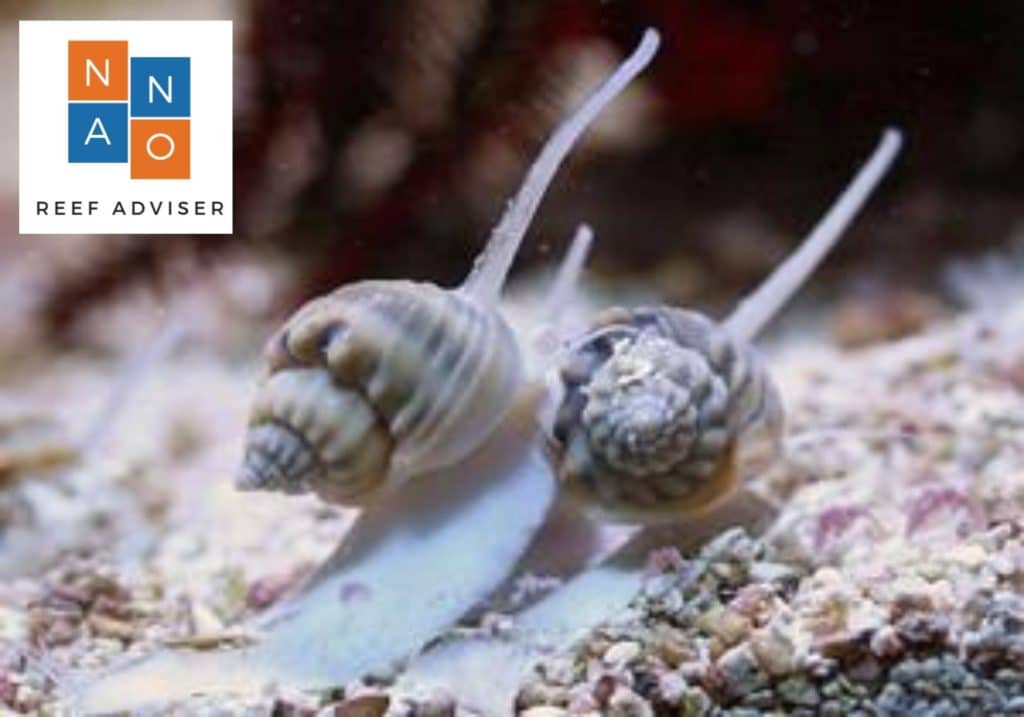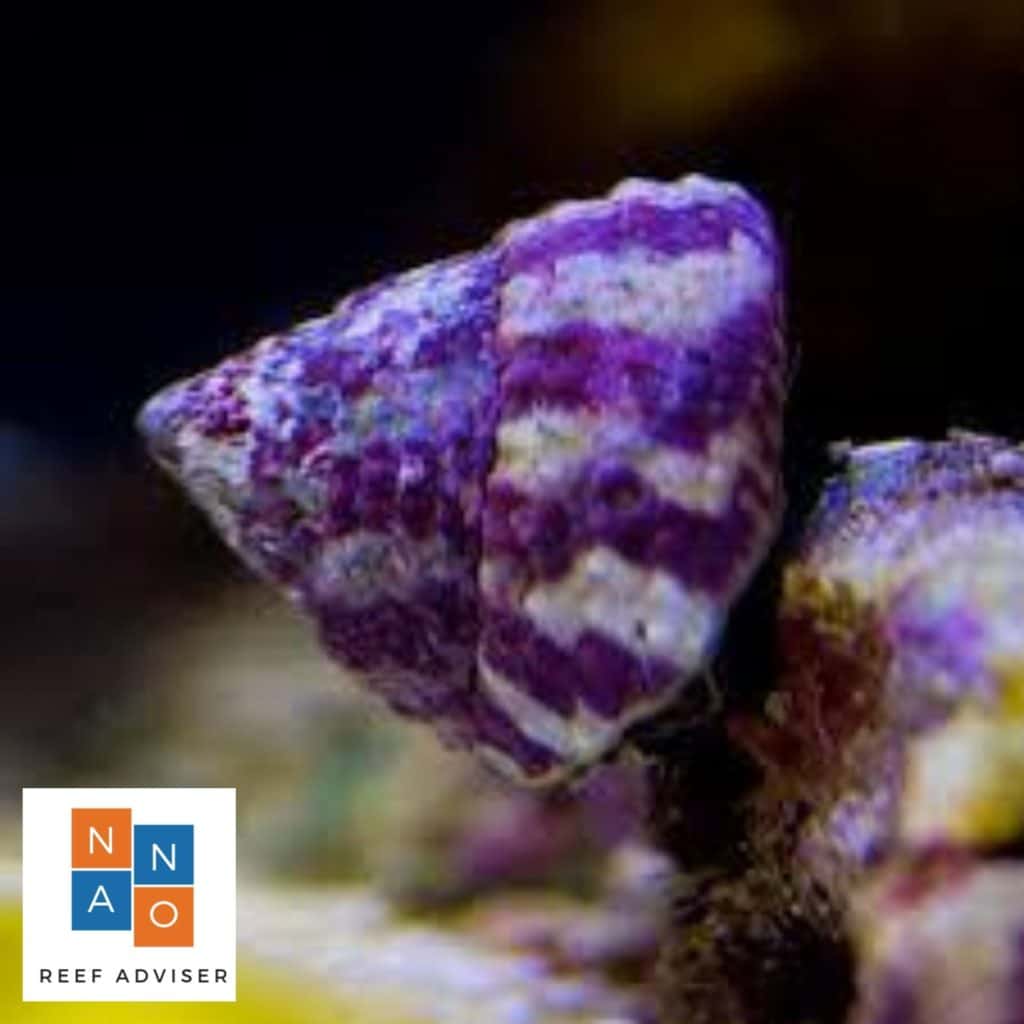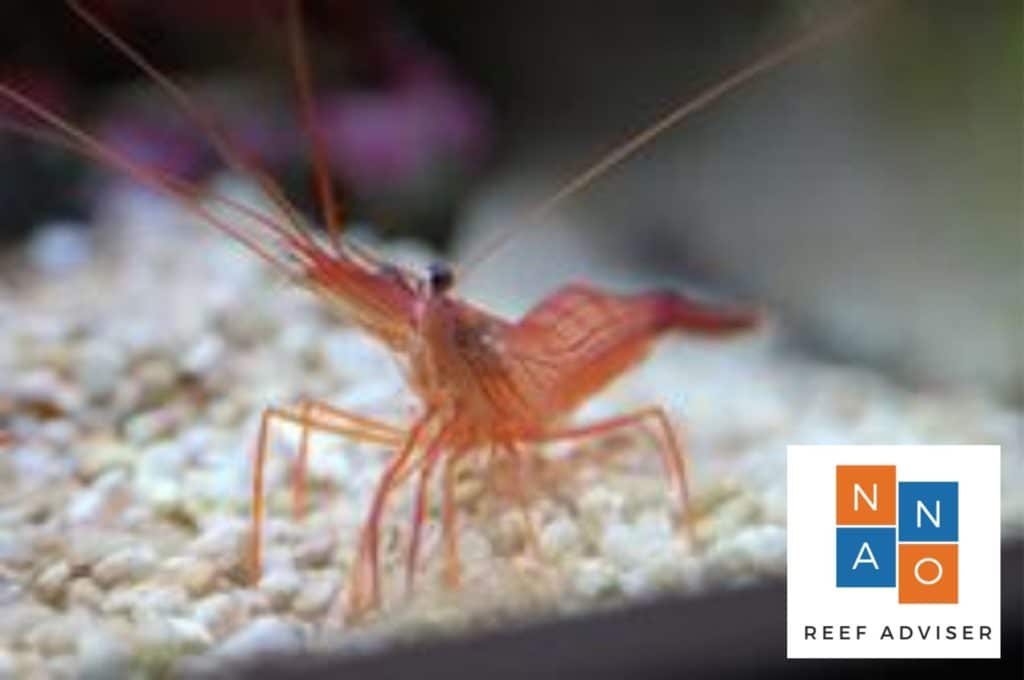What is the Best Clean-up Crew for a Reef Tank?
The best clean-up crew for a reef tank will contain a combination of beneficial invertebrates such as snails, crabs, urchins, and shrimp. The recommended quantity is based on your aquarium volume, with the maximum being one per gallon of water. Your fish, corals, and aquarium substrate will affect your clean-up crew selection.
- Turbo snail: The Turbo Snail is renowned for quickly eliminating large areas of algae
- Trochus snail: These snails consume film algae, hair algae, diatoms, and some species of cyanobacteria
- Blue-Legged Hermit Crab: The Blue Leg Hermit Crab is good at removing hair algae, film algae, detritus, and cyanobacteria from your tank.
- Cerith snail: The Cerith snail will normally eat diatoms, algae, and detritus it finds on your tank’s substrate (e.g., sand) and rocks.
- Nassarius snail: They will burrow deep into the substrate and eat detritus buried within.
- Bumble Bee snails: These snails are tiny and can get into small cracks and crevices in your live rock, removing detritus and sessile invertebrates like vermetid snails.
- Cleaner shrimp: This shrimp is a cleaner shrimp that supports fish health by removing parasites and dead tissue.
- Fighting conch: The conch lives its best life buried in the sand, using its siphon to search for uneaten fish food and detritus.
Get Live Clean-Up Crew for your Reef – Order Now!
Best Clean-up Crew for Reef Tanks
A well-thought-out clean-up crew is critical for a successful saltwater reef tank. Your clean-up crew is the ‘always vigilant worker’ that keeps things clean before a problem. If you wait until you have algae blooms to add your clean-up crew, you will be disappointed with the results.
Your clean-up crew will clean your reef tank by performing crucial ecological roles. They remove detritus, uneaten food, algae, parasites, and other harmful invertebrates. They are critical in your aquarium to keep your fish and corals healthy.
The following describes each recommended CUC member and what they can do for your reef tank. Our list includes very popular invertebrates that are sold in fish stores around the world and online.
Please scroll through the post to find what clean-up crew we recommend for your tank size and more.
What is the Best Clean-up Crew Snail?
Huge Assortment of Snails at Saltwaterfish.com
Astraea Snail: These snails (a/k/a Astrea snails) typically consume film algae from glass and rocks. The Astraea snails will occasionally eat hair algae as well.
Be Aware: You will likely have to flip over any Astraea snails that fall off the rock or glass – apparently, nature didn’t give them the good sense or the capability to flip themselves over! An upside-down snail will often time become someone else’s dinnertime meal.
Cerith Snail: The Cerith snail normally eats diatoms, algae, and detritus it finds on your tank’s substrate (e.g., sand) and rocks. These snails will eat off the sand but won’t bury themselves below the sand as the Nassarius snail will.
Nassarius Snail: These snails are excellent scavengers and sand stirrers. They are a must if your reef tank has a sand substrate. They require no special care or experience. They will burrow deep into the substrate and eat detritus buried within. They will emerge from the sand almost instantly whenever they smell food, like feeding your fish or coral.

Nassarius snails are not algae eaters! These snails eat detritus and leftover fish food. Their feeding will help maintain your substrate by removing the icky debris within. Keeping the sandbed cleaner reduces the degree of nutrients in the system, which reduces the potential for algae issues.
Tiger Conch: Like the Nassarius snail, the Conch will work the saltwater aquarium substrate from the sand’s surface and from within the sand. The Tiger Conch lives its best life buried in the sand, using its siphon to search for food. It’s like a submarine’s periscope looking for goodies on the surface instead of ships!
Interesting Fact: The Conch’s siphon will grow back if damaged! Resilient little buggers! And no, I don’t know that because I accidentally chopped my Tiger Conch’s siphon while cleaning the sand bed. Why would you ask such a thing?
The Tiger Conch will move onto rock areas low to the substrate and eat off the glass surfaces it can reach. They are very peaceful and easy to care for.
Other Conchs, such as Fighting Conchs, are also excellent reef tank citizens. Whichever type your saltwater aquarium store has in stock will work fine.
Trochus Snail: Trochus snails consume film algae, hair algae, diatoms, and some species of cyanobacteria. One of my personal favorites! These snails are excellent for cleaning the rocks and glass of your reef aquarium.

The Trochus’ benefit is knowing how to turn themselves right-side-up should they fall from the rock or glass. Too bad they can’t teach the Astraea snails how to do it!
Turbo Snail: The Turbo Snail is renowned for quickly eliminating large areas of algae. These large snails (3/4″ to 2″ in most aquarium shops) will travel your rocks and glass, devouring any algae in their way.
You won’t want to add any Turbo snails to your tank until algae are visible on the rock or glass surfaces – or you will need to supplement their diet with dried seaweed. Having to feed your clean-up crew is lame! The goal is to have your CUC eat the leftovers others leave behind as scavengers.
Bumble Bee Snails: The Bumble Bee Snails pack a lot of benefits into their tiny size. They can get into small cracks and crevices in your live rock, removing leftover fish food and detritus. The Bumble Bee snail will also eat sessile invertebrates like vermetid snails and polychaete worms.
Shrimp Safe for Reef Tanks
Blood Red Fire Cleaner Shrimp: The Blood Red Fire Shrimp is the most active nocturnal and loves rockwork with places to hide. This shrimp is a cleaner shrimp that supports fish health by removing parasites and dead tissue.
The Blood Red Fire Shrimp will also contribute to your reef tank’s overall health by searching out uneaten food in nooks and crannies.
Peppermint Shrimp: These can be a godsend should you find yourself with Aiptasia. Introduce them as one of the first shrimp you add to your reef, and you may never even know you have Aiptasia.
Aiptasia is a fast-growing nuisance anemone that is nearly impossible to eradicate. They are typically introduced into your reef tank as a tag-along on something you bring home from the aquarium store. Once you have Aiptasia, you likely have them forever.
Nano Reef Adviser
One downside to adding the Peppermint Shrimp as a solution to Aiptasia is that not every shrimp is the dedicated Aiptasia killer we hope for – so your mileage may vary.
Peppermint Shrimp eat detritus, uneaten food, and decomposing organic material from your rockwork and substrate. They are peaceful and easy to care for.

Skunk Cleaner Shrimp: This shrimp (a/k/a Red Skunk Cleaner Shrimp) isn’t for cleaning the tank as much as it is for cleaning… your fish! This cleaner shrimp will clean parasites and dead tissue from your fish, similar to the Blood Red Fire Cleaner Shrimp discussed earlier.
Add the Skunk Cleaner Shrimp to your tank, and he will station himself on your rockwork, waiting for the next customer.
The shrimp will eat typical fish foods such as frozen and flake foods. They are peaceful and easy to care for. Occasional supplemental iodine may be added to promote molting and growth.
What are the Best Hermit Crabs for a Clean-up Crew?
Check out the enormous selection of crabs from Saltwaterfish.com
Blue Leg Hermit Crab: The Blue Leg Hermit Crab is good at removing hair algae, film algae, detritus, and cyanobacteria from your tank. Effectiveness can be hit or miss on green hair algae.
All hermit crabs will resort to some obnoxious behavior if there isn’t enough food available. This includes taking food from anemones and other livestock in your tank.
I recommend the blue leg hermit crab over other hermits because I generally find they don’t destroy my corals or go berzerk after other crabs if they get a bit hungry.
Best Clean-up Crew: Danger Zone
The following clean-up crew members are good workers – but bring some bad attitudes to the job. Are you experienced enough to handle them?
Emerald Crab: The Emerald Crab is a great scavenger. They actively feed on leftover food as well as nuisance algae. They are pretty cool looking as well. They are probably best known as one of the cleanup crew that will eat bubble algae.
The downside to Emerald Crabs is that they will get aggressive if they do not have an ample food supply. So tiny fish and your beautiful corals could be the first to go!
Please read my full post on how to deal with bubble algae. Here’s a hint: Don’t take chances on whether an Emerald crab decides your corals taste better – and ignores the bubble algae altogether.
Urchins: Urchins, such as the Blue Tuxedo and Red Tuxedo, are night scavengers. They hide during the day and come out at night to roam the rocks and glass for algae. They are beautiful and can be a unique addition to your livestock.
One downside to Urchins is that they are the proverbial ‘bull in a china shop’ and will knock over anything that is not fixed. You can almost see the ‘chomp’ marks they leave behind. They are also so effective at cleaning algae growing on your rockwork that they will strip the beneficial Coralline algae that we all covet in our tanks.
Urchins can also collect interesting stuff that will stick to their spines as they move through your reef tank.
Sea Hare: The good news first! The Dolabella Sea Hare will eat your green hair algae like there is no tomorrow. My experience is that it is hands down the best at eliminating green hair algae.
Now the bad news. The Dolabella Sea Hare is definitely for experts only. They can excrete a toxic purple dye if startled and essentially wipe out your fish if startled or injured. I have personally had a couple die on me over the years with no negative effects. But you have been warned.
Sand Sifting Sea Star: These stars can quickly eliminate detritus and excess food waste in even the largest aquariums. They are peaceful, easy to care for, and reef safe.
The bad news is that these stars can eat other clean-up crew members, including shrimp, urchins, and even smaller sea stars. Once their food is gone, you may find they’ve retreated to the bottom of the sand bed to die and decay.
Here are the listings for our clean-up crew recommendations based on aquarium size.
The best clean-up crew set up for a 10-gallon nano reef tank:
- 2 Trochus snail: Glass and rock surfaces
- 2 Cerith snail: minor sand burrowing, rock surfaces
- 2 Nassarius snail: sand sifting
- 2 Bumblebee snails: rocks
The best clean-up crew for a 20-gallon nano reef tank:
- 4 Trochus snail
- 4 Cerith snail
- 2 Nassarius snail
- 4 Bumblebee snails
- 1 Peppermint shrimp or cleaner shrimp
- 1 Fighting conch: (1 for every 2 square feet of sand area maximum)
The best clean-up crew for a 30-gallon reef tank:
- 6 Trochus snail
- 4 Blue-Legged Hermit Crab
- 6 Cerith snail
- 4 Nassarius snail
- 6 Bumblebee snails
- 1 Peppermint shrimp or Cleaner shrimp
- 1 Fighting conch
The best clean-up crew for a 55-gallon reef tank:
- 2 Turbo snail
- 8 Trochus snail
- 6 Blue-Legged Hermit Crab
- 8 Cerith snail
- 4 Nassarius snail
- 8 Bumble Bee snails
- 1 Peppermint shrimp or Cleaner shrimp
- 1 Fighting conch
The best clean-up crew for a 75-100 gallon reef tank:
- 4 Turbo snail
- 10 Trochus snail
- 8 Blue Legged Hermit Crab
- 10 Cerith snail
- 6 Nassarius snail
- 10 Bumblebee snails
- 1 Peppermint shrimp
- 1 Cleaner shrimp
- 2 Fighting conch
Quantity of species per gallon
Here is a simple matrix of the information outlined above. Our recommended totals per tank size are much lower than websites that sell ‘clean up crew’ packages. I wonder why that is?

If you overload your reef tank with invertebrates, they will die from a lack of food. Their rotting and decaying bodies will increase the water’s nutrient levels, and you will create conditions that promote algae growth and bad water quality.
Keep in mind that you can always add more if needed.
Now that you know how to stock your reef tank with CUC, let’s answer some frequently asked clean-up crew questions.
What does clean-up crew mean?
Clean up crew, or CUC, is the umbrella aquarist term for the livestock in a saltwater aquarium that assists in removing waste, algae, and parasites from the reef tank ecosystem. They naturally eliminate detritus, uneaten food, parasites, etc. It typically includes copepods, Bristle Worms, snails, crabs, urchins, and shrimp.
Do I need to feed my clean-up crew?
Your clean-up crew should not require supplemental feeding. Overfeeding your fish so that there is additional waste and uneaten food for your clean-up crew can lead to algae blooms and other outbreaks that can crash your aquarium ecosystem.
If you bought CUC to solve a specialized problem, you might have to feed them once they eliminate the concern. For example, if you bought a Harlequin Shrimp to eliminate Asterina starfish, the shrimp will starve once the starfish have been eliminated. You will need to feed the shrimp additional starfish or remove it from your tank in this example.
You can ‘donate’ unneeded clean-up crew members to your local fish store. They likely won’t even give you store credit for them, but it’s better (and more ecologically sound) than flushing them down the toilet!
Quickly remove any dead clean-up crew members from your reef tank. Dead and decaying CUC can spike your ammonia, nitrite, nitrate, and phosphate parameters. This can lead to algae blooms and other issues the cleanup crew was supposed to solve in the first place.
What do I feed my clean up crew?
No supplemental feeding is required if you have the proper clean-up crew in your reef tank. However, if you do find the need to supplement the food supply, you can use the following dietary options:
- Dried seaweed sheets
- Trochus snails
- Turbo snails
- Margarita snails
- Tuxedo Urchin
- Pincushion Urchin
- Frozen Mysis shrimp
- Nassarius snails
- Peppermint Shrimp
- Cleaner Shrimp
- Caulerpa Macro Algae
- Sea Hare
- Starfish (usually Chocolate)
- Harlequin Shrimp:
When should I add a clean up crew?
You can begin adding clean-up crew members after the completion of your reef tank’s initial nitrogen cycling. Add additional clean-up crew gradually as algae begin to appear.
The best clean up crew for detritus
The best clean-up crew for detritus in a saltwater reef aquarium are Nassarius snails, Hermit crabs, sand-sifting starfish, and copepods. The snails and sand-sifting starfish clean the sand bed, the Hermit crabs work your rocks, and the copepods populate every other nook and cranny of your tank.
The best clean up crew for algae
Here is a list of the best algae fighters listed by algae type
- Green Hair Algae eaters: Astraea snails, Trochus snails, Blue Legged Hermit Crab, and the Sea Hare
- Film Algae eaters: Astraea snails, Trochus snails, Cerith snails, Turbo snails
- Bubble Algae eaters: Emerald Crab
Clean up crew fish
Your clean-up crew can contain more than just invertebrates. There are quite a few fish species that also contribute to the reef tank ecosystem’s health and balance. Fish can keep your reef tank and corals healthy by eating pests, parasites, and algae.
Here are a few fish with clean-up skills you can add to your reef. Be sure to research any fish you will add to your aquarium before you buy!
- Yellow Wrasse: The yellow wrasse (aka Yellow Coris or Canary Wrasse) can keep your corals safe by eating fireworms, tubeworms, flatworms, and pyramidellid snails. Best housed in a saltwater aquarium of 50 gallons and over.
- Six Line Wrasse: The six-line wrasse will help keep your corals safe by eating flatworms and pyramidellid snails. Best housed in a saltwater aquarium of 50 gallons and over.
- Kole Tang: Tangs, in general, will graze on algae over all of the aquarium surfaces. The Kole tang benefit is that the tang can be properly kept in a tank as small as 70 gallons.
- Bristletooth Tomini Tang is another option depending on what your local fish store carries.
- Tailspot Blenny: Here is a herbivore you can harvest your nuisance algae in tanks as small as 10 gallons.
- Sharknose Goby: This little goby is peaceful and will eat parasites from fishes in your saltwater aquarium. They can be kept in tanks as small as 10 gallons with other peaceful fish.
Get Live Clean-Up Crew for your Reef – Order Now!
Acclimating your clean-up crew
Here is a link to a short video on the proper acclimation of your clean-up crew. Acclimating your snails, crabs, urchins, and shrimp is critical to success. The worst thing that can happen is to add a clean-up crew and have them die. Adding more nutrients to your reef tank can compound your algae problems.